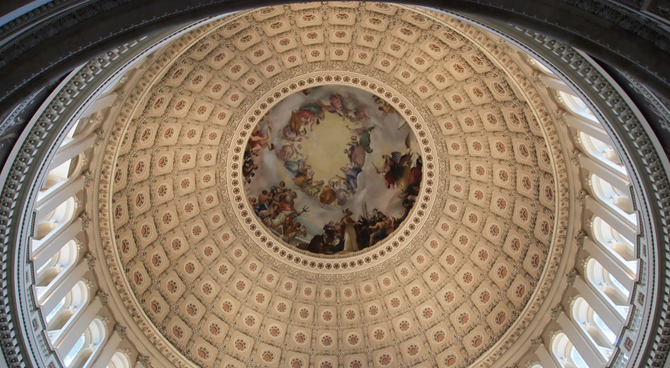This election will test the relative power of private-sector aspirations versus public-sector dependence.
By Phil Gramm and Mike Solon as appeared in Wall Street Journal on October 18, 2012
Since World War II, the five incumbent presidents who were re-elected enjoyed an economy where the unemployment rate averaged 5.4% in September of their election year, real GDP growth was 5.9% in the second quarter, and the University of Michigan Consumer Confidence Index in August was 97. Today the unemployment rate is 7.8%, real GDP growth in the second quarter was 1.3%, and the Consumer Confidence Index in August was 74.
Based on these economic measures, President Obama’s re-election would seem to be doomed.
But there is a new dynamic at work in 2012. Voter behavior in the past has been based on the performance of the private economy. Markedly different today is the dramatic growth of public-sector benefits.
In 1980 and 1992, only 3% of the American labor force drew disability benefits from the government. Today it is 6%. The number of workers qualifying for disability since the recession ended in 2009 has grown twice as fast as private employment.
How would Presidents Jimmy Carter or George H.W. Bush have fared on their Election Day if 40% of the Americans who were unemployed had instead qualified for disability benefits? How would voters have reacted in 1980 or 1992 if food-stamp benefits had grown by 65% instead of an average of less than 25% during the first four years of their administrations?
During the past four years, the Obama administration’s aggressive promotion of the food-stamp program has increased the number of recipients by 18.5 million. Do these people feel the same level of discontent about economic conditions as the rest of the voting population?
Unemployment insurance that lasted no longer than 55 weeks in 1980 and 72 weeks in 1992 now can last 99 weeks. Does this ease the distress level of the 40% of unemployed workers who have been out of work for more than half a year?
The federal government’s 120 means-tested programs today provide $1 trillion of benefits. The spending for these programs has grown 2½ times faster during the Obama presidency than in any other comparable period in American history. To what extent might these benefits not just foster dependency but also make the economy’s performance seem less of a deciding factor in voters’ choices?
Economic metrics associated with the defeat of previous incumbent presidents in the postwar period—September unemployment when Mr. Carter was running in 1980 was 7.5% and 7.6% for Mr. Bush in 1992—were a product of the economic environment of those times. The question to ask today is whether the old metrics apply in an age of vastly bigger government.
If you are concerned about your well-being and worried about a failed recovery—but getting new help from the government—do you vote for the candidate who promises more jobs or do you support the candidate who promises more government benefits? When tens of millions of people are gaining from the massive expansion of government programs in the past four years, the question is extremely relevant, especially when Mr. Obama’s victory in 2008, widely described as a blowout, involved a national margin of only 10 million votes.
No one has come closer to putting into words voter behavioral patterns in postwar America than Clint Eastwood at the Republican National Convention on Aug. 30. “Politicians are employees of ours,” he said. “And when somebody does not do the job, we got to let them go.”
Voters have historically set high standards and voted out incumbents not because they personally disliked them. Rather, they’ve elected a new president because they understood the importance of a strong economy to their jobs, their income and the future prospects of their children.
Based on the economy, Mr. Obama should lose on Nov. 6. Yet it seems implausible that tens of millions of Americans who have received additional government benefits during his presidency can be completely unaffected by that largess. The election will test the relative power of private-sector aspirations and public-sector dependence.
The choice is not a new one. The quest for opportunity versus the desire for government-granted security has dominated the democratic process since the ancient Greeks. It still drives the process in contemporary Greece—and everywhere else.
Yet if the desire for government benefits is now to drown out the economic aspirations that have guided voter choice for two-thirds of a century, something very significant must have happened in the past two years.
On Election Day in 2010, unemployment was 9.5%, GDP growth was 2% and the Consumer Confidence Index was 71. The food-stamp rolls had already grown by 54% since the beginning of the Obama administration, an additional 20 weeks of unemployment benefits had been added, disability rolls had grown twice as fast as employment rolls, and spending on means-tested government benefits was in the stratosphere. And when Americans turned out to vote on Nov. 2, 2010, six Senate Democrats lost their seats and Republicans picked up a staggering 63 seats in the House.
Two years ago, voters were not willing to dismiss pocketbook issues in the face of a massive two-year expansion of government benefits. The question that will be answered in this election is whether two additional years have tilted the scales and reduced the expectations of prosperity that Americans have set for their nation, their leaders and themselves.
Mr. Gramm, a former U.S. Senator from Texas, is senior partner at US Policy Metrics. Mr. Solon, a former economic policy adviser to Senate Republican Leader Mitch McConnell, is a partner at US Policy Metrics.
A version of this article appeared October 18, 2012, on page A15 in the U.S. edition of The Wall Street Journal, with the headline: Can Government Benefits Turn an Election?.





